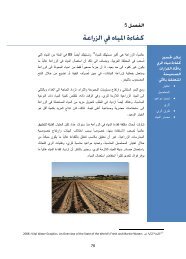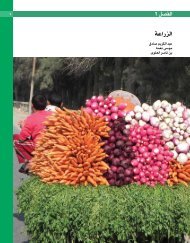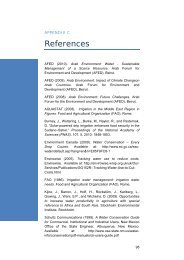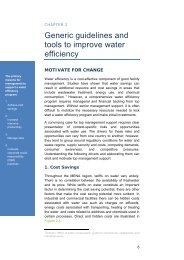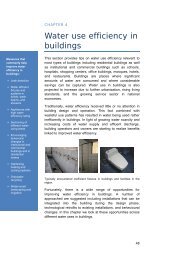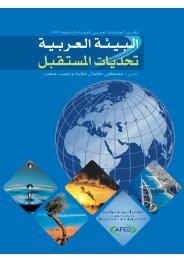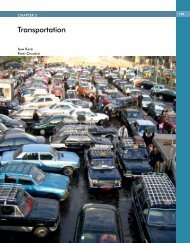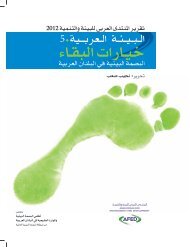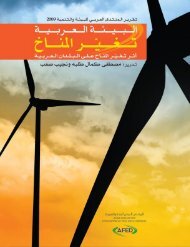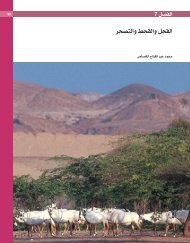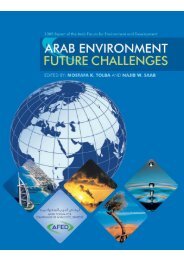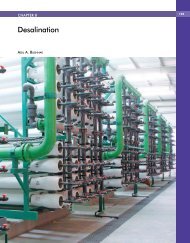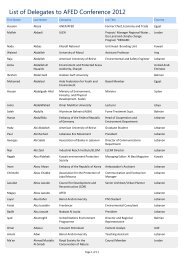Impact of Climate Change on Arab Countries - (IPCC) - Working ...
Impact of Climate Change on Arab Countries - (IPCC) - Working ...
Impact of Climate Change on Arab Countries - (IPCC) - Working ...
Create successful ePaper yourself
Turn your PDF publications into a flip-book with our unique Google optimized e-Paper software.
ARAB ENVIRONMENT: CLIMATE CHANGE 51<br />
tourism am<strong>on</strong>g <strong>Arab</strong> and European countries<br />
<str<strong>on</strong>g>of</str<strong>on</strong>g> the regi<strong>on</strong>.<br />
The Red Sea and Gulf <str<strong>on</strong>g>of</str<strong>on</strong>g> Aden<br />
Sub-regi<strong>on</strong><br />
The Red Sea has a surface area <str<strong>on</strong>g>of</str<strong>on</strong>g> about 450,000<br />
km2 and varies in width from 30 to 280 kilometres.<br />
It has an average depth <str<strong>on</strong>g>of</str<strong>on</strong>g> about 500m, with<br />
extensive shallow shelves well known for their<br />
marine life and corals. The southern entrance at<br />
Bab-el-Mandab is <strong>on</strong>ly 130m deep, which<br />
restricts water exchange <str<strong>on</strong>g>of</str<strong>on</strong>g> water between the Red<br />
Sea and the Gulf <str<strong>on</strong>g>of</str<strong>on</strong>g> Aden (Gerges, 2002), hence<br />
the sea is vulnerable to increasing polluti<strong>on</strong> by<br />
land-based sources from surrounding countries as<br />
well as the heavy shipping traffic through this passage.<br />
The Red Sea is also c<strong>on</strong>sidered a very<br />
important water way for oil from the Gulf area<br />
through the Suez Canal to Europe.<br />
Resources <str<strong>on</strong>g>of</str<strong>on</strong>g> the Red Sea and Gulf <str<strong>on</strong>g>of</str<strong>on</strong>g> Aden are a<br />
source <str<strong>on</strong>g>of</str<strong>on</strong>g> ec<strong>on</strong>omic, social and cultural prosperity,<br />
providing subsistence and commercial food<br />
supplies, as well as domestic and internati<strong>on</strong>al<br />
tourist destinati<strong>on</strong>s. They also provide a strategically<br />
important transport route for shipping<br />
(especially petroleum products) and trading <str<strong>on</strong>g>of</str<strong>on</strong>g><br />
rich and varied cultural heritage. Together, they<br />
are also a globally significant repository <str<strong>on</strong>g>of</str<strong>on</strong>g> marine<br />
and coastal biodiversity, having the highest biodiversity<br />
<str<strong>on</strong>g>of</str<strong>on</strong>g> any enclosed sea.<br />
The Red Sea is a rich and diverse ecosystem. It<br />
c<strong>on</strong>tains fairly distinct faunal species subsets,<br />
many <str<strong>on</strong>g>of</str<strong>on</strong>g> which are unique. Approximately 6.3%<br />
<str<strong>on</strong>g>of</str<strong>on</strong>g> the coral species are endemic to the Red Sea.<br />
Mangrove and seagrass communities are an<br />
important feature <str<strong>on</strong>g>of</str<strong>on</strong>g> the coastal areas and provide<br />
significant productivity and input <str<strong>on</strong>g>of</str<strong>on</strong>g> nutrients.<br />
Inshore, halophytic salt marsh vegetati<strong>on</strong> and<br />
sabkhas (seas<strong>on</strong>ally flooded low-lying coastal<br />
plains) cover much <str<strong>on</strong>g>of</str<strong>on</strong>g> the coast (Gerges, 2002).<br />
The Red Sea is characterized by its high biodiversity<br />
<str<strong>on</strong>g>of</str<strong>on</strong>g> marine habitats, life, corals and sea grass. It<br />
therefore attracts tourism from all over the world<br />
all year around. A large number <str<strong>on</strong>g>of</str<strong>on</strong>g> highly populated<br />
resorts and diving centres have been established<br />
with a variety <str<strong>on</strong>g>of</str<strong>on</strong>g> tourism services. Tourism<br />
centres have been established at many coastal<br />
areas al<strong>on</strong>g the Red Sea including the Gulf <str<strong>on</strong>g>of</str<strong>on</strong>g><br />
Suez and Gulf <str<strong>on</strong>g>of</str<strong>on</strong>g> Aqaba. In additi<strong>on</strong>, large tourist<br />
and ec<strong>on</strong>omic cities such as Sharm El Sheikh and<br />
Hurghada as well as a number <str<strong>on</strong>g>of</str<strong>on</strong>g> industrial cities<br />
such as Suez, Jeddah and Aqaba are situated al<strong>on</strong>g<br />
its coast.<br />
The ROPME Gulf Sub-regi<strong>on</strong><br />
The ROPME Gulf sub-regi<strong>on</strong> has a surface area<br />
<str<strong>on</strong>g>of</str<strong>on</strong>g> 239,000 km 2 , a mean depth <str<strong>on</strong>g>of</str<strong>on</strong>g> 36 m, and an<br />
average volume <str<strong>on</strong>g>of</str<strong>on</strong>g> 8,630,000 km 3 . Because <str<strong>on</strong>g>of</str<strong>on</strong>g> the<br />
relative shallowness and water clarity <str<strong>on</strong>g>of</str<strong>on</strong>g> the<br />
coastal areas, the Gulf supports highly productive<br />
coastal habitats, such as the extensive intertidal<br />
mudflats, seagrass and algae beds, mangroves and<br />
coral reefs (Munawar, 2002). The most pressing<br />
envir<strong>on</strong>mental c<strong>on</strong>cerns include the decline <str<strong>on</strong>g>of</str<strong>on</strong>g><br />
seawater quality, degradati<strong>on</strong> <str<strong>on</strong>g>of</str<strong>on</strong>g> marine and<br />
coastal envir<strong>on</strong>ments, coral bleaching and coastal<br />
reclamati<strong>on</strong> (ROPME, 2004).<br />
The sub-regi<strong>on</strong> is also extremely rich in terms <str<strong>on</strong>g>of</str<strong>on</strong>g><br />
marine life, and it hosts many good fishing<br />
grounds, extensive coral reefs, and abundant pearl<br />
oysters. It has come under pressures from fast<br />
urbanizati<strong>on</strong> and industrializati<strong>on</strong>. In particular,<br />
petroleum spillages during the recent wars and<br />
c<strong>on</strong>flicts have placed severe stresses <strong>on</strong> the regi<strong>on</strong>.<br />
III. ISSUES OF MAIN CONCERN<br />
The <strong>Arab</strong> world’s coastal regi<strong>on</strong>s suffer from a<br />
number <str<strong>on</strong>g>of</str<strong>on</strong>g> important envir<strong>on</strong>mental problems<br />
including:<br />
• Populati<strong>on</strong> growth, unemployment and<br />
shortage <str<strong>on</strong>g>of</str<strong>on</strong>g> awareness<br />
Populati<strong>on</strong> growth rates in the coastal regi<strong>on</strong>s are<br />
much higher than those in other regi<strong>on</strong>s, which<br />
are already high. The shortage <str<strong>on</strong>g>of</str<strong>on</strong>g> employment<br />
opportunities is the main c<strong>on</strong>cern <str<strong>on</strong>g>of</str<strong>on</strong>g> many <str<strong>on</strong>g>of</str<strong>on</strong>g> the<br />
<strong>Arab</strong> countries not <strong>on</strong>ly because <str<strong>on</strong>g>of</str<strong>on</strong>g> the low capacities<br />
but also <str<strong>on</strong>g>of</str<strong>on</strong>g> the shortage <str<strong>on</strong>g>of</str<strong>on</strong>g> specialized experts.<br />
• Unplanned Urbanizati<strong>on</strong><br />
Many <strong>Arab</strong> coastal cities are expanding at high<br />
rates, without due c<strong>on</strong>siderati<strong>on</strong> to planning for<br />
future needs. Many slum areas are being created<br />
with associated shortages <str<strong>on</strong>g>of</str<strong>on</strong>g> adequate sanitati<strong>on</strong><br />
and socioec<strong>on</strong>omic problems. In additi<strong>on</strong>, the<br />
shortage <str<strong>on</strong>g>of</str<strong>on</strong>g> proper land use planning has created<br />
many problems <str<strong>on</strong>g>of</str<strong>on</strong>g> services and overc<strong>on</strong>sumpti<strong>on</strong>.



